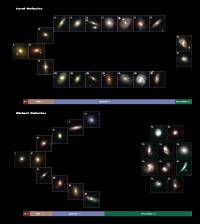Forming the present-day spiral galaxies [heic1002]
4 February 2010
Using data from the NASA/ESA Hubble Space Telescope, astronomers have, for the first time, created a demographic census of galaxy types and shapes from a time before the Earth and the Sun existed, to the present day. The results show that, contrary to contemporary thought, more than half of the present-day spiral galaxies had so-called peculiar shapes only 6000 million years ago, which, if confirmed, highlights the importance of collisions and mergers in the recent past of many galaxies. It also provides clues for the unique status of our own galaxy, the Milky Way.
 |
|
Comparing the Hubble sequence (a demographic census of galaxy types) at two different points in the history of the Universe. |
A team of European astronomers led by François Hammer of the Observatoire de Paris has, for the first time, completed a demographic census of galaxy types at two different points in the Universe's history - in effect, creating two Hubble sequences - that help explain how galaxies form [2]. In this survey, researchers sampled 116 local galaxies and 148 distant galaxies.
Contrary to previous thought, the astronomers showed that the Hubble sequence six thousand million years ago was very different from the one that astronomers see today.
"Six thousand million years ago, there were many more peculiar galaxies than now - a very surprising result," says Rodney Delgado-Serrano, lead author of the related paper recently published in and highlighted on the cover of Astronomy & Astrophysics. "This means that in the last six thousand million years, these peculiar galaxies must have become normal spirals, giving us a more dramatic picture of the recent Universe than we had before."
The astronomers think that these peculiar galaxies did indeed become spirals through collisions and merging. Tracing the history of galaxy formation leads us to the way our Universe presently looks. Like any review of a life, there are chaotic, tumultuous times and more dormant periods and, like many teenagers, developing galaxies often collide with those in their way. Crashes between galaxies give rise to enormous new galaxies and, although it was commonly believed that galaxy mergers decreased significantly eight thousand million years ago, the new result implies that mergers were still occurring frequently after that time - up to as recently as four thousand million years ago.
"Our aim was to find a scenario that would connect the current picture of the Universe with the morphologies of distant, older galaxies - to find the right fit for this puzzling view of galaxy evolution," says Hammer.
Also contrary to the widely held opinion that galaxy mergers result in the formation of elliptical galaxies, Hammer and his team support a scenario in which these cosmic clashes result in spiral galaxies. In a parallel paper published in Astronomy & Astrophysics [3], Hammer and his team delve further into their "spiral rebuilding" hypothesis, which proposes that peculiar galaxies affected by gas-rich mergers are slowly reborn as giant spirals with discs and central bulges.
Although our own Milky Way galaxy is a spiral galaxy, it seems to have been spared much of the teenage drama; its formation history has been rather quiet and it has avoided violent collisions in astronomically recent times. However, the large Andromeda galaxy from our neighbourhood has not been so lucky and fits well into the "spiral rebuilding" scenario. Researchers continue to seek out explanations for this.
Hammer and his team used data from the Sloan Digital Sky Survey [4] undertaken by Apache Point Observatory, New Mexico, USA and from the GOODS field and Hubble Ultra Deep Field taken by the Advanced Camera for Surveys (ACS) aboard Hubble.
Notes for editors
[1] Hubble's scheme divides regular galaxies into three broad classes - ellipticals, lenticulars and spirals - based on their visual appearance (originally on photographic plates). A fourth class contains galaxies with an irregular appearance.
[2] R. Delgado-Serrano, et al., 2010, How was the Hubble Sequence, 6 Giga-years ago?, Astronomy & Astrophysics, 509, A78
[3] F. Hammer et al., 2009, The Hubble Sequence: just a vestige of merger events?, Astronomy & Astrophysics, 507, 1313
[4] Over eight years of operations, the Sloan Digital Sky Survey (SDSS) obtained deep, multicolour images covering more than a quarter of the sky and created three-dimensional maps containing more than 930 000 galaxies and more than 120 000 quasars. The SDSS used a dedicated 2.5-metre telescope at Apache Point Observatory, New Mexico, equipped with two powerful special purpose instruments. The 120-megapixel camera imaged 1.5 square degrees of sky at a time, about eight times the area of the full Moon. A pair of spectrographs fed by optical fibres measured spectra of (and hence distances to) more than 600 galaxies and quasars in a single observation.
Image credit: NASA, ESA, Sloan Digital Sky Survey, R. Delgado-Serrano and F. Hammer (Observatoire de Paris)
Contacts
Colleen Sharkey
Hubble/ESA, Garching, Germany
Tel: +49 89 3200 6306
Cell: +49 151 153 73591
E-mail: csharkey eso.org
eso.org
François Hammer
GEPI - Observatoire de Paris/CNRS and the Université Paris-Diderot
Tel: + 33 1 45 07 74 08
E-mail: francois.hammer obspm.fr
obspm.fr

